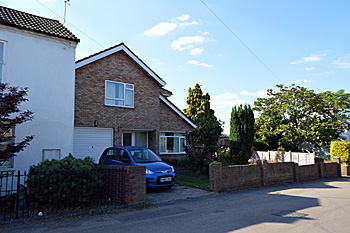The Former Houghton Conquest Poor House
 The site of the parish workhouse August 2016
The site of the parish workhouse August 2016
Until 1834 most parishes in the country had their own workhouse, into which the poor and infirm were put when they were either homeless or unable to look after themselves. In 1801 Thomas Lilburne, working for Justice of the Peace Samuel Whitbread made the following report on the workhouse [W1/763]:
“Certificate of the State of the Poor House called Cobb Hall in the parish of Houghton Conquest in the County of Bedford”.
“The house consists of two rooms below, with one fire place, joists are laid for two rooms above, but without floors, except a few old boards on a small part. There are no shutters or glazing to the windows except a few old quarries ; - about 4/5 of the thatch is completely off, & the other part extremely bad, the rafters are naked and no other covering whatever to the house”.
“The above house in its present condition was the residence of Thomas Linger, his wife and one child, till within a few days past”.
“The carpenter’s begun to do some repairs on Monday 7th December 1801”.
“Examined by Authority from Samuel Whitbread Esq one of His Majesty’s Justices of the Peace for the County of Bedford the 10th day of December 1801 [Signed] Thomas Lilburne”.
In 1816 an inventory of the things in the workhouse was made. It reads (with original spellings) as follows [P11/12/4]: “6 Bedsteads; 6 Straw beds; 2 Flock ditto; 19 Sheets; 8 Blankets; 5 Coverlids; 8 Bolsters; 3 Boxes; 1 Long Table; 1 Small Ditto; 1 Dozen mess tins; 2 Pans Ditto; 6 Plates; 2 Tin ketles; 1 Brass Ditto; 1 Copper Ditto; 1 Iorn Boiler; 1 Copper Ditto; 1 Stool; 1 Form; 7 Chears; 1 Pail; 3 Candlesticks; 2 Pair of Tongues; 2 Pair Bellows; 2 Pothooks; 1 Tub”.
In 1834 Poor Law Unions were introduced. This meant an end of parish workhouses. The homeless and destitute were now sent to the large workhouses in nearby towns run by the local union. In the case of Houghton Conquest that meant the workhouse in Ampthill, which was later the Cedars Old people’s Home and has now [2016] suffered the inevitable fate of such buildings, having been turned into the ubiquitous luxury flats.
The Houghton Conquest workhouse stood on the site of what is now 24 Rectory Lane, which looks as if it was built around the 1970s. The Rating and Valuation Act 1925 specified that every building and piece of land in the country was to be assessed to determine its rateable value. The valuer visiting the cottage [DV1/C78/130] found it owned by Mrs Packwood, who had the butcher’s shop next door, and occupied by J W Cooper, whose rent of £1/19/- per quarter was regarded by the valuer as “absurd”.
The cottage comprised a living room, kitchen, washhouse, pantry, dairy and three bedrooms. A derelict barn stood outside. The valuer commented: “Was workhouse years ago. Would put more than it is worth to put in repair” and “Dark old place onlt 2 beds habitable … no garden”.